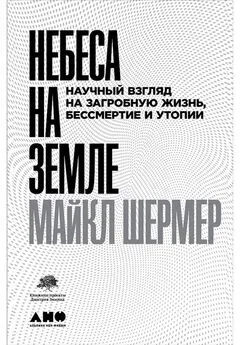Майкл Мобуссин - Больше, чем вы знаете. Необычный взгляд на мир финансов
- Название:Больше, чем вы знаете. Необычный взгляд на мир финансов
- Автор:
- Жанр:
- Издательство:Array Литагент «Альпина»
- Год:2014
- Город:Москва
- ISBN:978-5-9614-3247-3
- Рейтинг:
- Избранное:Добавить в избранное
-
Отзывы:
-
Ваша оценка:
Майкл Мобуссин - Больше, чем вы знаете. Необычный взгляд на мир финансов краткое содержание
Больше, чем вы знаете. Необычный взгляд на мир финансов - читать онлайн бесплатно ознакомительный отрывок
Интервал:
Закладка:
4. О распределении Зипфа см.: Robert L. Axtell, “Zipf Distribution of U. S. Firm Sizes”, Science 293 (September 2001); 1818–1820.
5. Это не совсем правильное употребление термина «закон больших чисел». Более подробное объяснение см.: Peter L. Bernstein, Against the Gods: The Remarkable Story of Risk (New York: John Wiley and Sons, 1996), 122–23.
6. Jeremy J. Siegel, Stocks for the Long Run , 3rd ed. (New York: McGraw Hill, 2002), 150–56.
7. Joseph Fuller and Michael C. Jensen, “Dare to Keep Your Stock Price Low”, The Wall Street Journal , December 31, 2001.
8. Alfred Rappaport, “The Economics of Short-Term Performance Obsession”, Financial Analysts Journal 61, no. 3 (May-June 2005): 65–79.
Часть IV. Наука и теория сложности
Глава 28. Разнообразьте свое мышление
1. См. доклад Нормана Джонсона «Чем полезен более широкий взгляд на вещи (или Падение Дома экспертов)» на Форуме новаторов в CSFB, сентябрь 2000 г., Санта-Фе, Нью-Мексико; http://www.capatcolumbia.com/CSFBTLF/
2. 2000/johnson00_sidecolumn.pdf.
3. Michael J. Mauboussin, “Revisiting Market Efficiency: The Stock Market as a Complex Adaptive System”, Journal of Applied Corporate Finance 14. No. 4 (Winter 2002): 47–55.
4. Norman L. Johnson, “Diversity in Decentralized Systems: Enabling Self-Organizing Solutions”, LANL , LA-UR-99–6281, 1999. Дополнительную информацию на эту тему см. на сайте: http://ishi.lanl.gov.
5. James Kennedy and Russell C. Eberhart, Swarm Intelligence (San Francisco: Morgan Kaufmann, 2001), 105.
6. William H. Calvin, “The Emergence of Intelligence”, Scientific American Presents 9, no. 4 (November 1998): 44–51.
7. Gary Klein, Sources of Power: How People Make Decisions (Cambridge, Mass.: MIT Press, 1998).
8. Michael T. Kaufman, Soros: The Life and Times of a Messianic Billionaire (New York: Knopf, 2002), 141.
9. См. статью «Неформальное обучение на рабочем месте» на сайте http://www.learning-org.com/98.01/0331.html.
10. Arthur Zeikel, “Organizing for Creativity”, Financial Analyst Journal 39 (November-December 1983): 25–29.
Глава 29. От меда до денег
1. Thomas D. Seeley, The Wisdom of the Hive: The Social Psychology of Honey Bee Colonies (Cambridge, Mass.: Harvard University Press, 1995), 259. Также см.: http://www.pbs.org/wgbh/nova.bees.
2. Цит. по Steven Johnson, Emergence: The Connected Lives of Ants, Brains, Cities, and Software (New York: Scribner, 2001), 33.
3. Seeley, The Wisdom of the Hive, 240–62; также см.: http://www.nbb.cornell.edu/neurobio/
4. department/Faculty/seeley/seeley.html.
5. Eric Bonabeau, Marco Dorigo, and Guy Theraulaz, Swarm Intelligence: From Natural to Artificial Systems (New York: Oxford University Press. 1999), 39–55. Также см. Edmund Burke and Graham Kendall, “Applying Ant Algorithms and the No Fit Polygon to the Nesting Problem”, University of Nottingham Working Paper , 1999; http://www.asap.cs.nott.ac.uk/publications/pdf/gk_ai99.pdf.
6. Сайт IEM: http://www.biz.uiowa.edu/iem.
7. James Surowiecki, “Decisions, Decisions”, The New Yorker , March 28, 2003, доступно на сайте http://www.newyorker.com/archive/2003/
8. 03/24/030324ta_talk_surowiecki.
9. Сайт фондовой биржи Голливуда: http://www.hsx.com.
10. Сайт биржи BetFair: http://www.betfair.com.
11. Alfred Rappaport and Michael J. Mauboussin, Expectations Investing (Boston, Mass.: Harvard Business School Press, 2001), 132–34.
12. Howard Rheingold, Smart Mobs: The Next Social Revolution (New York: Perseus, 2002).
13. Ken Brown, “Stocks March to the Beat of War, Weak Economy”, Wall Street Journal , March 31, 2003.
Глава 30. Глас народа
1. Michael Idinopulos and Lee Kempler, “Do You Know Who Your Experts Are?” The McKinsey Quarterly 4 (2003): 60–69; см.: http://www.mckinseyquarterly.com/
2. article_abstract.asp?ar=1358&L2=18&L3=31&srid=6&gp=1.
3. Nancy Weil, “Innocentive Pairs R&D Challenges with Researchers”, Bio-IT World , May 29, 2003.
4. Некоторые компании пытаются создать внутренний механизм поиска решений конкретных проблем. Например, в Hewlett-Packard действует система, которая называется SHOCK (Social Harvesting of Community Knowledge – Общество пожинает плоды знаний пользователей); см.: http://www.hpl.hp.com/research/idl/projects/shock.
5. Francis Galton, “Vox Populi”, Nature 75 (March 7, 1907): 450–451; reprint 1949. James Surowiecki, The Wisdom of Crowds: Why the Many Are Smarter Than the Few and How Collective Wisdom Shapes Business, Economies, Societies and Nations (New York: Doubleday, 2004).
6. Norman L. Johnson, “Collective Problem Solving: Functionality Beyond the Individual”. LA-UR-98–2227 (1998); Jack L. Treynor, “Market Efficiency and the Bean Jar Experiment”, Financial Analysts Journal (May-June 1987): 50–53; Sherry Sontag and Christopher Drew, Blind Man’s Bluff: The Untold Story of America Submarine Espionage (New York: Perseus Books, 1998), 58–59.
7. Kay-Yut Chen, Leslie R. Fine, and Bernardo A. Huberman, “Predicting the Future”, Information Systems Frontiers 5, no. 1 (2003): 47–61, http://www.hpl.hp.com/shl/papers/future/future.pdf.
Глава 31. Миром правят толстые хвосты
1. Альберт Эйнштейн считал, что броуновское движение взвешенной в воде пыльцы является результатом хаотичных толчков теплового движения со стороны молекул воды.
2. См.: GloriaMundi, “Introduction to VaR”, http://www.gloriamundi.org/introduction.asp.
3. Edgar E. Peters, Fractal Market Analysis (New York: John Wiley & Sons, 1994), 21–27.
4. Roger Lowenstein, When Genius Failed: The Rise and Fall of Long-Term Capital Management (New York: Random House, 2000), 72. Ловенстейн цитирует статью Дженса Карстена Джекверта и Марка Рубинстайна (Jens Carsten Jackwerth and Mark Rubinstein, “Recovering Probability Distributions from Option Prices”, Journal of Finance 51, no. 5 (December 1996): 1612). Джекверт и Рубинстайн отмечают, что если исходить из волатильности рынка в годовом исчислении на уровне 20 % и логнормального распределения, то 29 %-ное падение цены фьючерсов на S&P 500 является событием в диапазоне 27 стандартных отклонений и с вероятностью 10–160.
5. Per Bak, How Nature Works (New York: Springer-Verlag, 1996).
6. См. главу 22.
7. Suchil Bikchndani and Sunil Sharma, “Herd Behavior in Financial Markets”, IMF Staff Paper 47, no. 3 (2001), http://www.imf.org/External/Pubs/FT/
8. staffp/2001/01/pdf/bikchan.pdf.
9. Michael S. Gibson, “Incorporating Event Risk into Value-and-Risk”, The Federal Reserve Board Finance and Economics Discussion Series , 2001–17 (February 2001); http://www.federalreserve.gov/pubs/feds/
10. 2001/200117/200117abs.html.
Глава 32. Интегрируя частности
1. Daniel Bernoulli, “Exposition of a New Theory on the Measurement of Risk”, Econometrica , 22 (January 1954): 23–36. Впервые статья была опубликована в 1738 г. Саму игру изначально предложил двоюродный брат Даниила – Николаус.
2. См.: Стэнфордская философская энциклопедия, статья «Санкт-петербургский парадокс», http://plato.stanford.edu/entries/paradox-stpetersburg.
3. Этот раздел широко опирается на статью Ларри Либовича и Даниэлы Шерле «Два урока из фракталов и хаоса» (Larry S. Liebovitch and Daniela Scheurle, “Two Lessons from Fractals and Chaos”, Complexity , Vol. 5, 4, 2000, 34–43. См.: http://www.ccs.fau.edu/˜liebovitch/complexity-20.html.
4. См. главу 29.
5. Benoit B. Mandelbrot, “A Multifractal Walk down Wall Street”, Scientific American , February 1999, 70–73. См. также: Benoit B. Mandelbrot, Fractals and Scaling in Finance: Discontinuity, Concentration, Risk (New York: Springer Verlag, 1997).
6. Если бросать монету без остановки по 16 часов в день (с восьмичасовым перерывом на сон) и тратить на каждый бросок по три секунды, то на выполнение 100 млн бросков уйдет 14,3 года.
7. Didier Sornette, Why Stock Markets Crash: Critical Events in Complex Financial Systems (Princeton, N. J.: Princeton University Press, 2003) [21]; также см. веб-сайт Сорнетта: http://www.ess.ucla.edu/faculty/sornette/.
8. См. еще одну классическую статью Питера Бернстайна «Растущие компании или акции роста»; Peter L. Bernstein, “Growth Companies Vs. Growth Stocks”, Harvard Business Review (September-October 1956): 87–98.
9. Peter L. Bernstein, Against the Gods: The Remarkable Story of Risk (New York: John Wiley & Sons, 1996), 99–100.
10. David Duran, “Growth Stocks and the Petersburg Paradox”, Journal of Finance 12 (September 1957): 348–63.
11. Stephen R. Waite, Quantum Investing (New York: Texere, 2002), 129.
12. Michael J. Mauboussin, Bob Hiler, and Patrick J. McCarthy, “The (Fat) Tail that Wags the Dog”, Credit Suisse First Boston Equity Research , February 4, 1999.
Глава 33. «Мечта смотрителя»
1. Цит. в статье Сандры Блэйксли; см.: Sandra Blakeslee, “Scientist at Work: John Henry Holland; Searching for Simple Rules of Complexity”, New York Times , December 26, 1995.
2. William H. Calvin, How Brains Think: Evolving Intelligence, Then and Now (New York: Basic Books, 1996).
3. John H. Holland, Hidden Order: How Adaption Builds Complexity (Reading, Mass.: Helix Books, 1995), 10–37.
4. См. главу 11.
5. Michael J. Mauboussin, “Revisiting Market Efficiency: The Stock Market as a Complex Adaptive System”, Journal of Applied Corporate Finance 14. No. 4 (Winter 2002): 47–55.
6. Norman L. Johnson, “Diversity in Decentralized Systems: Enabling Self-Organizing Solutions”, LANL , LA-UR-99–6281, 1999.
Читать дальшеИнтервал:
Закладка:










